29 January 2024
The toponym Europe is widely claimed to come from ancient Greek Εὐρώπη (Europé), the name of a Phoenician princess of Tyre who was abducted by Zeus in the form a bull. The tale dates to the Mycenaean period (1750–1050 BCE). Variations of the tale as to exactly who Europa was and where she came from exist, but the basic element of abduction by the god in the form of a bull is consistent. The myth does not explain how her name became associated with the continent.
Several alternatives to the mythical origin have been proposed. One has it coming from the ancient Greek εὐρωπός (europos) meaning wide or broad. Another has it coming from either the Akkadian erebu (to go down, set) or the Phoenician ereb (evening, west) making the name something like “land of the setting sun.” Both of these are unlikely.
Its use as a place name in English dates to the Old English period. It appears in the opening of the Old English translation of Orosius’s Historiarum adversum paganos (History Against the Pagans). Orosius wrote it in the early fifth century CE, and the Old English translation dates to the turn of the ninth century. It’s less of a translation and more of an adaptation and expansion of Orosius’s Latin text:
Ure yldran ealne ðysne ymbhwyrft ðyses middangeardes, cwæþ Orosius, swa swa Oceanus ymbligeþ utan, þone man garsægc hatað, on þreo todældon and hy þa þry dælas on þreo tonemdon: Asiam and Europem and Affricam, þeah ðe sume men sædon þæt þær næran buton twegan dælas, Asia and þæt oþer Europe. Asia is befangen mid Oceanus þæm garsecge suþan and norþan and eastan and swa ealne middangeard from eastdæle healfne behæfð. Þonne on ðæm norþdæle, þæt is Asia on þa swiþran healfe in Danai þære ie, ðær Asia and Europe togædre licgað. And þonne of þære ilcan ie Danai suþ andlang Wendelsæs and þonne wiþ westan Alexandria þære byrig Asia and Affica togædere licgeað.
(Orosius said that our ancestors divided the whole circle of this earth into three parts, surrounded by the sea called Ocean, and they named these three parts Asia and Europe and Africa, though some people said that there were only two parts, Asia and the other being Europe. Asia is encompassed by the sea of Ocean south and north and east and contains all the eastern half of the earth. In the northern part, that is Asia on the right side of the river Don, there the boundaries of Asia and Europe run together. And then from the river Don the border runs south along the Mediterranean and then Asia and Africa meet west of the city of Alexandria.)
Sources:
Everett-Heath, John. Concise Oxford Dictionary of World Place Names, sixth ed. Oxford: Oxford UP, 2020. Oxfordreference.com.
Godden, Malcolm R., ed. The Old English History of the World: An Anglo-Saxon Rewriting of Orosius. Dumbarton Oaks Medieval Library 44. Cambridge: Harvard UP, 2016, 24.
Oxford English Dictionary, third edition, June 2008, s.v. Europe, n., Europa, n., European, adj. and n.
Image credit: London, British Library, MS Royal 12 F.IV, fol. 135v. Wikimedia Commons. Public domain image.

